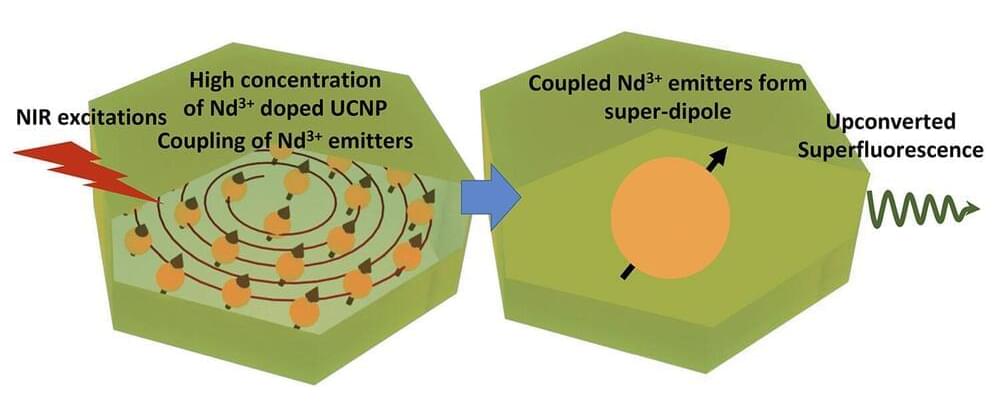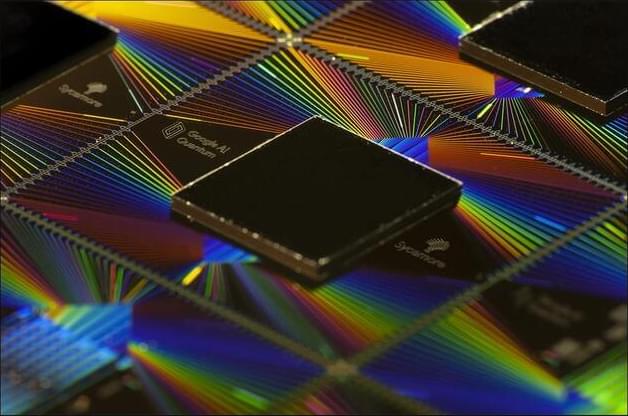A team of scientists from the Max Planck Institute of Quantum Optics recently demonstrated a record-breaking experiment that could turn the quantum computing industry on its…



Researchers looking to synthesize a brighter and more stable nanoparticle for optical applications found that their creation instead exhibited a more surprising property: bursts of superfluorescence that occurred at both room temperature and regular intervals. The work could lead to the development of faster microchips, neurosensors, or materials for use in quantum computing applications, as well as a number of biological studies.
Superfluorescence occurs when atoms within a material synchronize and simultaneously emit a short but intense burst of light. The property is valuable for quantum optical applications, but extremely difficult to achieve at room temperatures and for intervals long enough to be useful.
The material in question—lanthanide-doped upconversion nanoparticle, or UCNP—was synthesized by the research team in an effort to create a “brighter” optical material. They produced hexagonal ceramic crystals ranging from 50 nanometers (nm) to 500 nm in size and began testing their lasing properties, which resulted in several impressive breakthroughs.

Were you unable to attend Transform 2022? Check out all of the summit sessions in our on-demand library now! Watch here.
As the architecture, engineering and construction (AEC) industry is undergoing a staggering growth in the creation of data, organizations need to place a strong focus on data governance best practices.
That is one of the findings of a new study of the AEC sector that reveals it has experienced a 31.2% compound growth rate in data storage since 2017. The amount of new data being captured or created is staggering, but getting full value from it depends on how the data is managed, stored, accessed and protected.




This will be very useful in progressing the field of quantum computers and communication.
Researchers at the Max Planck Institute of Quantum Optics set a new record after achieving a quantum entanglement of 14 photons, the largest on record so far, an institutional press release said.
Quantum entanglement, famously described by Albery Einstein as “spooky action at a distance” is a phenomenon where particles become intertwined in such a way that they cease to exist individually, and changing the specific property of one results in an instant change of its partner, even if it is far away.
Physicists at the Max Planck Institute of Quantum Optics have managed to entangle more than a dozen photons efficiently and in a defined way. They are thus creating a basis for a new type of quantum computer.
In order to effectively use a quantum computer, a larger number of specially prepared – in technical terms: entangled – basic building blocks are needed to carry out computational operations. A team of physicists at the Max Planck Institute of Quantum Optics in Garching has now for the very first time demonstrated this task with photons emitted by a single atom. Following a novel technique, the researchers generated up to 14 entangled photons in an optical resonator, which can be prepared into specific quantum physical states in a targeted and very efficient manner. The new method could facilitate the construction of powerful and robust quantum computers, and serve the secure transmission of data in the future.


Watch a movie backwards and you’ll likely get confused—but a quantum computer wouldn’t. That’s the conclusion of researcher Mile Gu at the Centre for Quantum Technologies (CQT) at the National University of Singapore and Nanyang Technological University and collaborators.
In research published 18 July in Physical Review X, the international team shows that a quantum computer is less in thrall to the arrow of time than a classical computer. In some cases, it’s as if the quantum computer doesn’t need to distinguish between cause and effect at all.
The new work is inspired by an influential discovery made almost 10 years ago by complexity scientists James Crutchfield and John Mahoney at the University of California, Davis. They showed that many statistical data sequences will have a built-in arrow of time. An observer who sees the data played from beginning to end, like the frames of a movie, can model what comes next using only a modest amount of memory about what occurred before. An observer who tries to model the system in reverse has a much harder task—potentially needing to track orders of magnitude more information.
